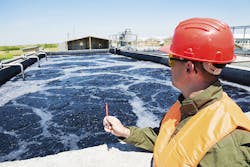Researchers at Virginia Tech have developed a system for ammonia recovery from wastewater using bacteria.
The discovery could help remove the pollutant from waterways and capture it for commercial use, the university reported on Tuesday.
If too much ammonia is discharged into a watershed, it promotes the growth of harmful algal blooms. But in agriculture, ammonia is a valuable commodity. The demand for ammonia-based fertilizer is so high that the process used to produce ammonia from nitrogen gas consumes 1 percent of the world’s electricity.
“We use so much energy to convert nitrogen gas into fertilizer, and then in wastewater treatment we consume a lot of energy to convert ammonia into nitrogen gas,” said Jason He, an associate professor of civil and environmental engineering in the College of Engineering at Virginia Tech. “A system that recovered the ammonia for later use, instead of just removing it, would be of great interest to sustainable wastewater treatment.”
Mohan Qin, a second-year doctoral student in He’s lab, has built a system for ammonia recovery and removal other contaminants while generating electricity at the same time.
It does this by combining two existing technologies: a microbial electrochemical cell, in which bacteria carry out electron-shuttling chemical reactions, and a forward osmosis cell, which uses a highly concentrated solution to draw clean water through a membrane, leaving impurities behind.
This hybrid system produces ammonia, clean water and electricity from wastewater.
Qin is currently working on computer models to examine why the system works so well and how it could be further improved. Meanwhile, he is working with local water treatment plants to establish a research facility that incorporates a pilot-scale model of the combined microbial electrochemical and forward osmosis cells.
